Articles about the menstrual cycle usually focus on reproduction and period symptoms rather than helping you discover patterns that affect your entire body. Observing your menstrual cycle can alert you to ideal times to socialize, do focused work, be intimate, increase training intensity, or prioritize some R&R.
Traditional menstrual cycle diagrams depict a stylized cycle, marching through a cookie-cutter set of steps and a 28-day timeline. However, those diagrams reflect knowledge that is over 60 years old, and we’ve learned a lot since then!
Modern research makes it clear that menstrual cycles vary widely between individuals, and in the same person from cycle-to-cycle.
So, rather than settle for general advice that is unlikely to match your experience, you can use modern tools, like Oura, to identify your menstrual cycle and map how it affects different systems in your body. These insights can help you adapt your routine to each cycle phase.
To learn the phases of your menstrual cycle, and how Oura can help you spot the impact, read on.
READ MORE: Busting the 14-Day Ovulation Myth
What Are The Phases Of Your Cycle?
Although “cycles,” by definition, have no beginning or end, people tend to divide the menstrual cycle into key events. Depending on which article you read, you’ll see slightly different terms, but they’re all describing the same events: Your follicular & luteal phases.
- Your follicular phase includes menstruation and important events called your “periovulatory period,” which helps your body prepare to release an egg or “ovulate.” Once you ovulate, you shift phases.
- Your luteal phase is your transition to either supporting a pregnancy or starting a new cycle.
READ MORE: Using Oura Temperature To Track Your Menstrual Cycle
The average length, and incredible variability of each of these events are shown in the image below.
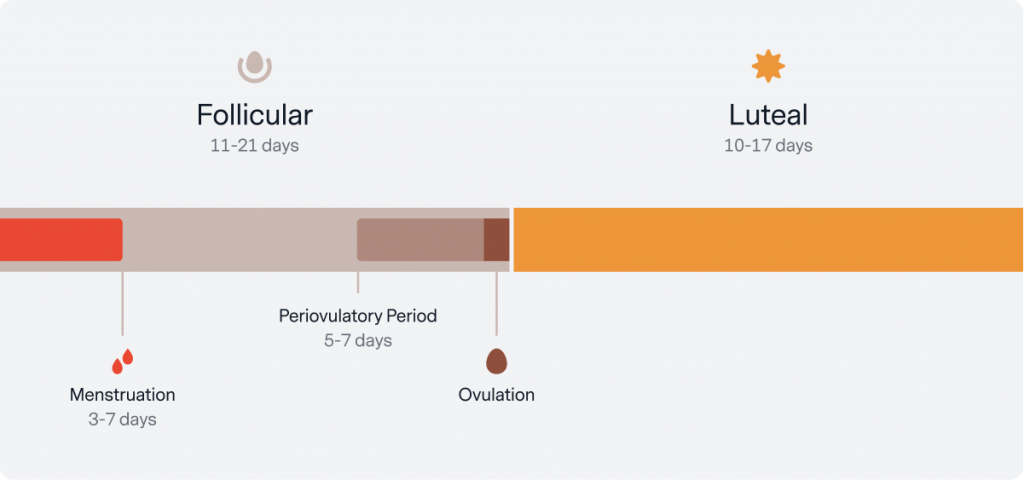
With each of these events, specific hormones coordinate activity in your reproductive organs, heart, lungs, muscles, brain, and other systems in your body. There are many important hormonal players in this process, but we’ll focus on three (estrogen, luteinizing hormone (LH), and progesterone).
You may already be familiar with how these hormones encourage the uterus to grow and shed its lining and the ovaries to prepare and release an egg; what might be less familiar are the terms “follicular” and “luteal.”
“Follicular” refers to the fact that each of your eggs is contained in a sack within your ovary called a follicle. At the start of your follicular phase, a batch of 20-30 follicles develops on each of your ovaries.
Around ovulation, one follicle is “chosen” as the dominant egg, while the remaining follicles are naturally broken down. (Don’t worry, you still have ~100,000 eggs even in your mid-20s!)
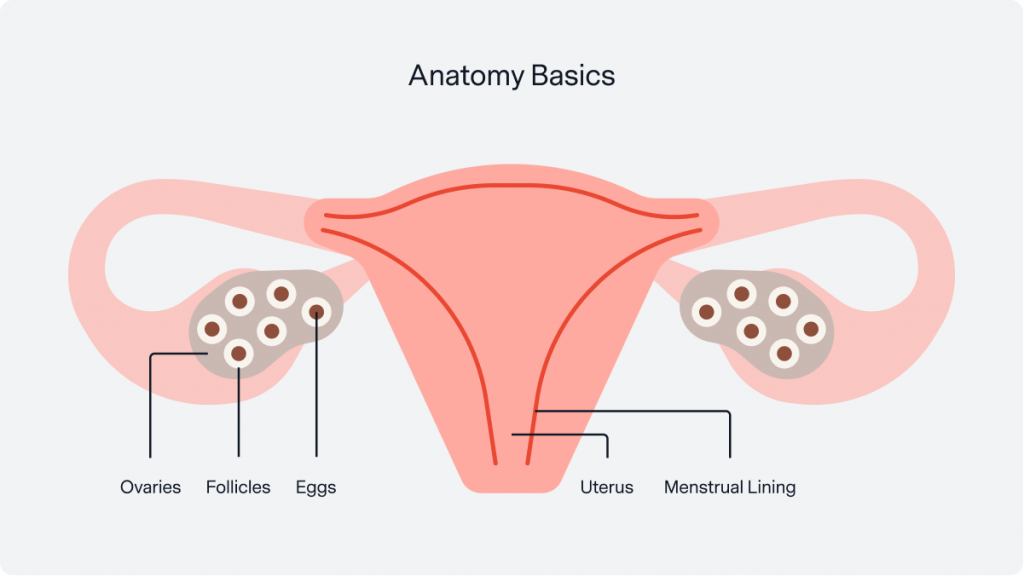
“Luteal” refers to how your chosen follicle becomes a helpful hormone generator after ovulation. Once your follicle releases the egg, the cells in your follicle take on a new purpose; they transform into a luteal body that releases progesterone and estrogen to support a potential pregnancy.
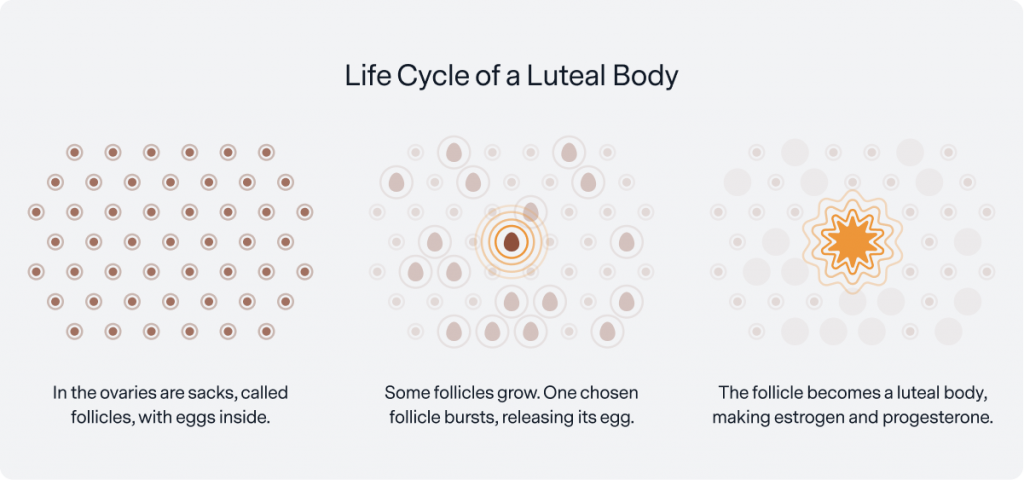
In the image below, you can see how your hormones relate to your menstrual cycle’s phases. Each hormone peaks in a particular phase: Estrogen during follicular, LH prior to ovulation, and progesterone during luteal.
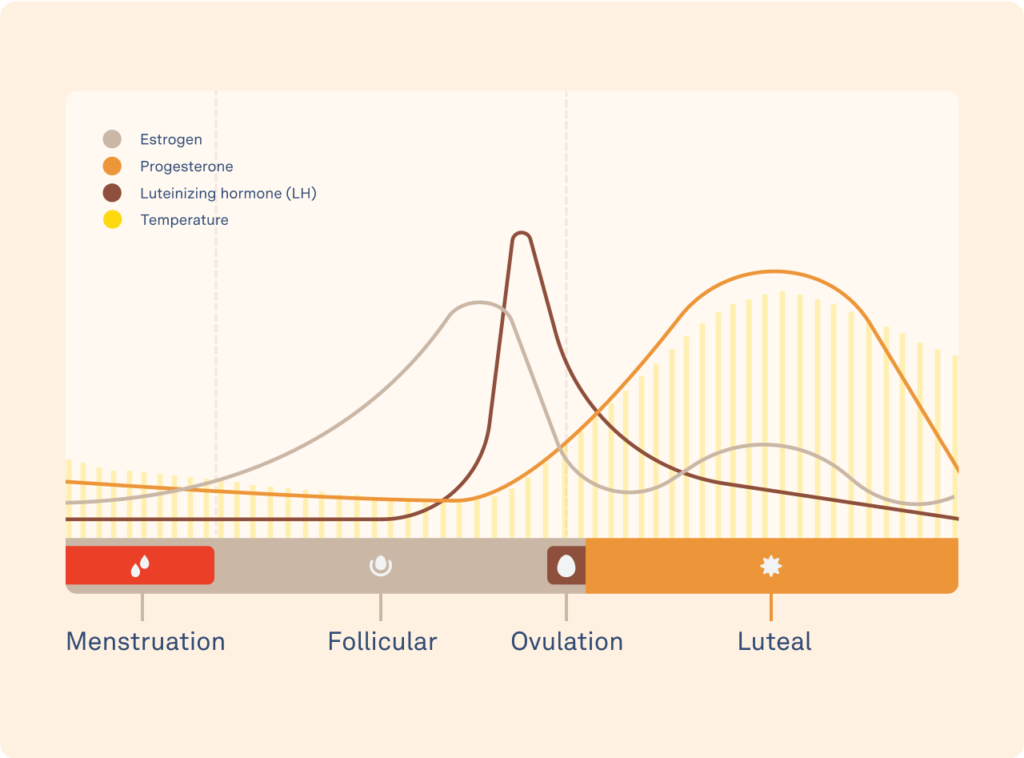
- Menstruation starts your follicular phase with decreasing progesterone, low estrogen, and low LH.
- As your follicular phase continues, your developing follicles produce more and more estrogen.
- Towards the end of your follicular phase, approaching ovulation (your “periovulatory period”), high levels of estrogen, and other factors, set off a flood of luteinizing hormone. This “LH surge” triggers ovulation.
- Your luteal phase starts after ovulation, with your luteal body releasing increasing amounts of progesterone and a small bump in estrogen. As your luteal phase continues, high levels of progesterone thicken the lining of the uterus and prevent contractions.
- Eventually, your luteal body recedes, causing progesterone and estrogen to drop off. As these hormones fall, the top layers of the uterine lining break down and are shed in the form of menstrual bleeding to start a new cycle.
READ MORE: How Oura Data Can Help You Understand Your Menstrual Cycle
What Patterns Can You Look For?
You can spot the timing of these menstrual cycle phases by monitoring the way that hormone fluctuations impact your brain, heart, lungs, reproductive system, and more. These changes show up as patterns in your body temperature, resting heart rate (RHR), heart rate variability (HRV), and respiratory rate.
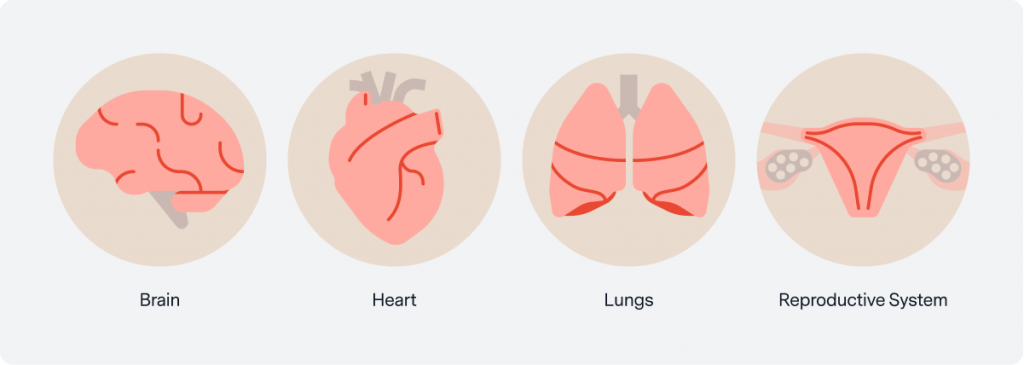
Keep in mind that these are generalized patterns, and observing your body’s rhythms will be your most helpful tool. Avoid comparing your numbers to someone else’s (a “high” temperature or RHR in your luteal phase might be another person’s “low” follicular phase reading). Note that individuals on hormonal birth control will see different trends.
READ MORE: Oura Partners With FDA-Cleared Birth Control App, Natural Cycles°
Below is a broad overview of typical patterns:
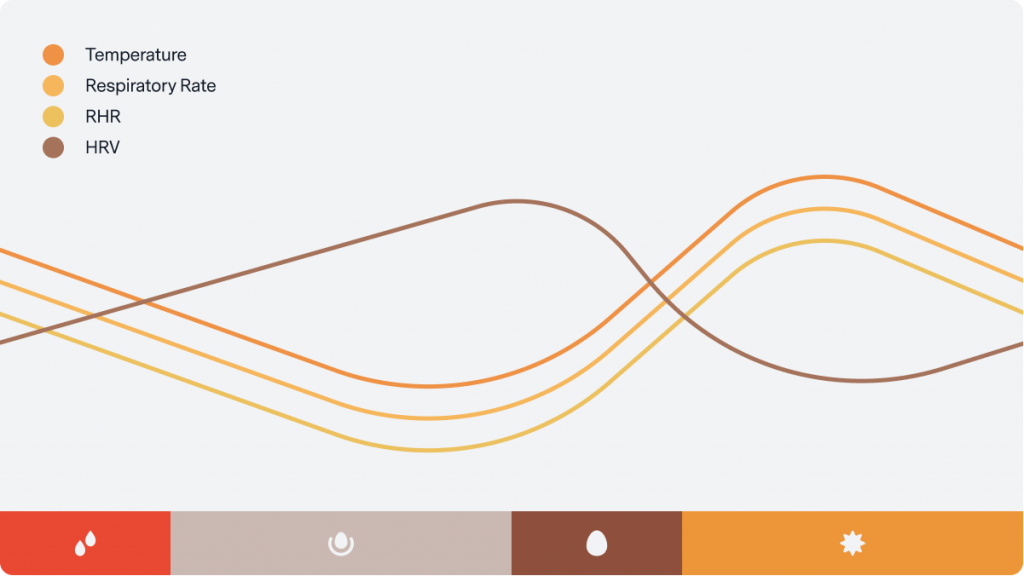
For more details on the patterns you can expect within each phase, keep reading.
During Menstruation
Alongside symptoms like cramping, your menstruation usually signals a return to better sleep and recovery.
At the start of each cycle, progesterone and estrogen decline. This drop in hormones is associated with decreasing RHR and respiratory rate, alongside increasing HRV. The speed at which these changes occur will depend on your body or, more precisely, by how quickly your progesterone and estrogen decrease in a given cycle.
Your body temperature is also highly impacted by estrogen and progesterone. Although there are some complex dynamics at play, generally, estrogen decreases your temperature while progesterone raises it. With falling progesterone levels during menstruation, you’re likely to see your temperature decrease.

During Your Follicular Phase
Your follicular phase may support peak athletic performance and sociability. Although there is still more research to be done, higher estrogen levels during the follicular phase may also boost cognition and creativity.
As a group of your follicles develop, they produce increasing amounts of estrogen, and your uterine lining rebuilds to create the best environment for a potentially fertilized egg. This increase in estrogen not only impacts your reproductive system, but affects your heart, lungs, and muscles, resulting in a lower temperature, RHR, and respiratory rate, alongside higher HRV. Although the research is still emerging, these trends, which you might already associate with feeling “better,” may also promote improved athletic performance.
READ MORE: How to Align Your Training With Your Menstrual Cycle

Around Ovulation
As your body builds up momentum to release an egg, you may experience a disruption that leaves you feeling out of sorts for a day or so.
High estrogen levels and other factors set off a cascade across your brain and body that results in an LH surge, which triggers ovulation. The phrases “LH surge” and “ovulation” are often used interchangeably — but these events are actually distinct, with the LH surge almost always happening first! Look out for this common misconception when reading about cycles.
So, what does this mean for fertility? The LH surge and ovulation make up part of your “fertile window,” the time during the menstrual cycle when you may become pregnant (typically 5-7 days). We still have a lot to learn about how long this window is for each individual and what symptoms come along with it.
Around ovulation, these changes can cause rising temperatures, RHR, and respiratory rate alongside declining HRV. This is also the time when many women experience “mittelschmerz,” an achy abdominal sensation that scientists think indicates contractions in the fallopian tube as it begins transporting your egg towards your uterus.

During Your Luteal Phase
During your luteal phase, you are likely to experience hotter temperatures, a higher metabolism, lower energy, and a desire to prioritize comfort and rest.
During your early luteal phase, your now-empty follicle transforms into a luteal body, which produces increased levels of progesterone and delivers a bump in estrogen. Your LH levels decrease, and the lining of your uterus starts to thicken as a landing pad for a potentially fertilized egg.
Across this phase, rising progesterone directly increases your body temperature and the activity in your fight-or-flight system. This activity interacts with systems across your body and can be spotted in an elevating RHR, temperature, and respiratory rate, alongside declining HRV.

As your luteal phase continues, your body reaches a turning point:
- If your egg is fertilized, your body prepares for pregnancy and progesterone rises even higher, causing the extra high temperatures you can spot in early pregnancy.
- If your egg is not fertilized, progesterone and estrogen drop off again and your cycle restarts. As you get closer to your next menstrual period, the trends listed above will level off as these hormones decline.
For many, the decline in estrogen and progesterone as the luteal phase transitions into menstruation can manifest negatively. Individual experiences vary widely by symptom and intensity. This is the time when people may experience breast tenderness, fluid retention, bloating, cramps, cravings, mood swings, tiredness, or anxiety, collectively known as “PMS” (premenstrual syndrome).
Keep in mind that just because you’re a cycling individual doesn’t mean you’ll experience PMS. Scientists are currently questioning whether the idea should be reframed to more accurately reflect individual differences in the luteal phase.
Using Oura to Understand Your Cycle

Cycle phases change from person to person and cycle to cycle, and one individual might ovulate earlier or have an extended luteal phase compared to another. You might ovulate on day 15 one cycle, and day 18 the next. It’s even normal to have a cycle that skips ovulation, an “anovulatory cycle,” from time to time.
These wide ranges highlight how important it is to understand your personal cycle – if you’re aiming to avoid pregnancy or land your fertility target, a shift in a single phase can make a big difference.
Because the Oura Ring measures your RHR, HRV, respiration, sleep, and body temperature, it can be a helpful tool for spotting your cycle and discovering its impact on your body.
Oura now offers a Cycle Insights feature, which uses these key biosignals to provide a five-day prediction window for the start of your next cycle and period. This will allow you to track your menstrual cycle over time and to feel more informed and empowered in your body.
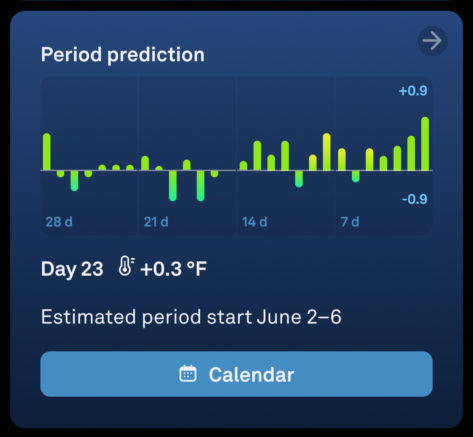
READ MORE: New to Oura: Cycle Insights
Keep in mind that your cycle length may also change over time. Past birth control usage is associated with cycle irregularities during recovery and younger women tend to have longer cycles.
Moreover, factors like your genetic background, body composition, and exercise habits may also influence your cycles. And, even with all these current insights, there are many more patterns yet to be discovered.
Future Research – What’s Next?
For science to catch up with the complexity of our bodies, a lot more work needs to be done, but, in the meantime, we can help others by learning together, sharing our observations, and building momentum. This effort could build a new library of information about women’s physiology.
Beyond these signals (RHR, HRV, body temperature, respiration), research is starting to show that your menstrual cycle can affect your sleep. These effects can potentially pop up as increased REM sleep during your follicular phase, increased deep sleep in your early luteal phase, and poorer sleep towards the end of your luteal phase with lower sleep efficiency, a higher number of awakenings, and more fragmented sleep.
READ MORE: Can PMS Cause Insomnia and Affect Your Sleep Quality?




